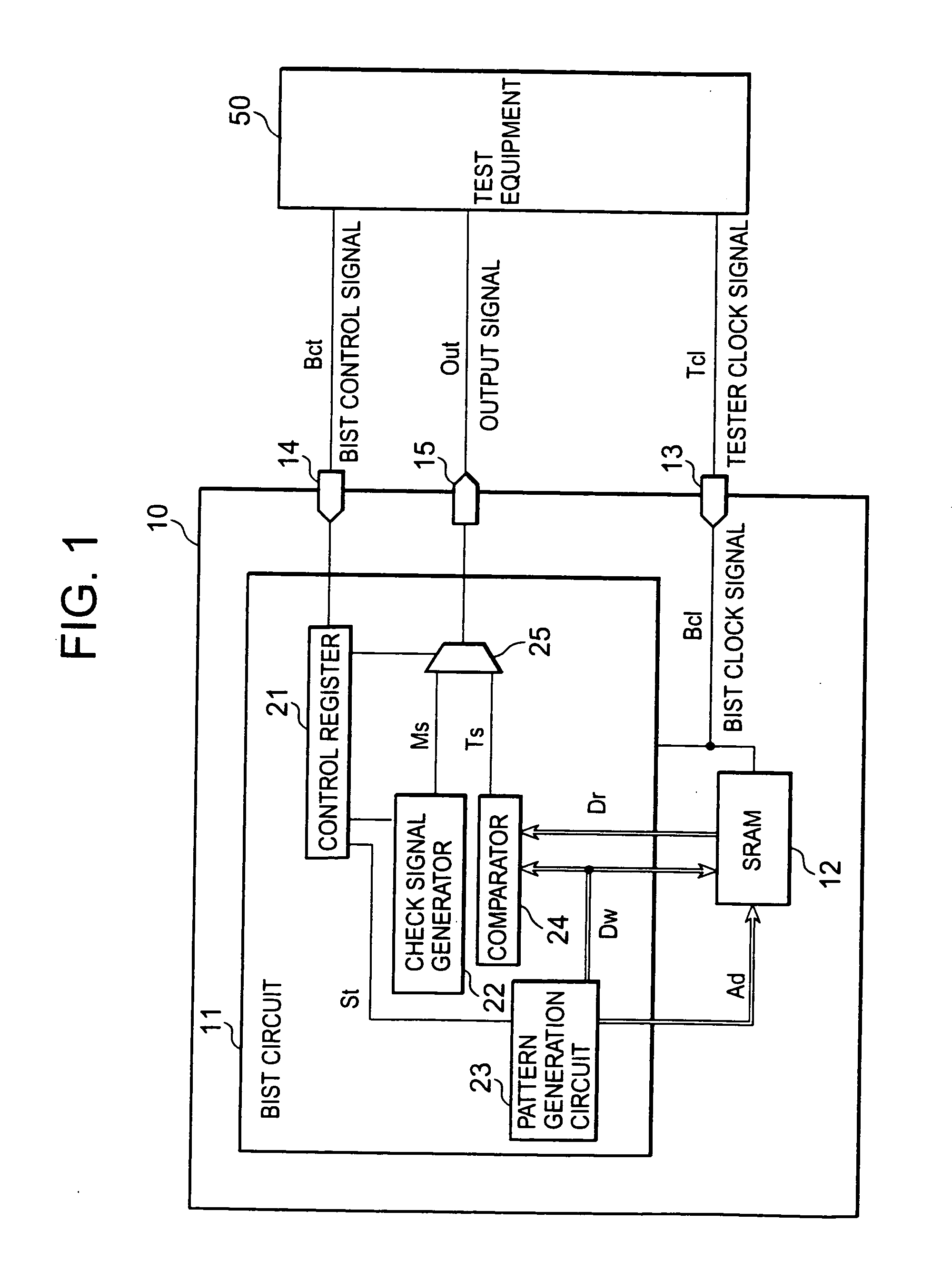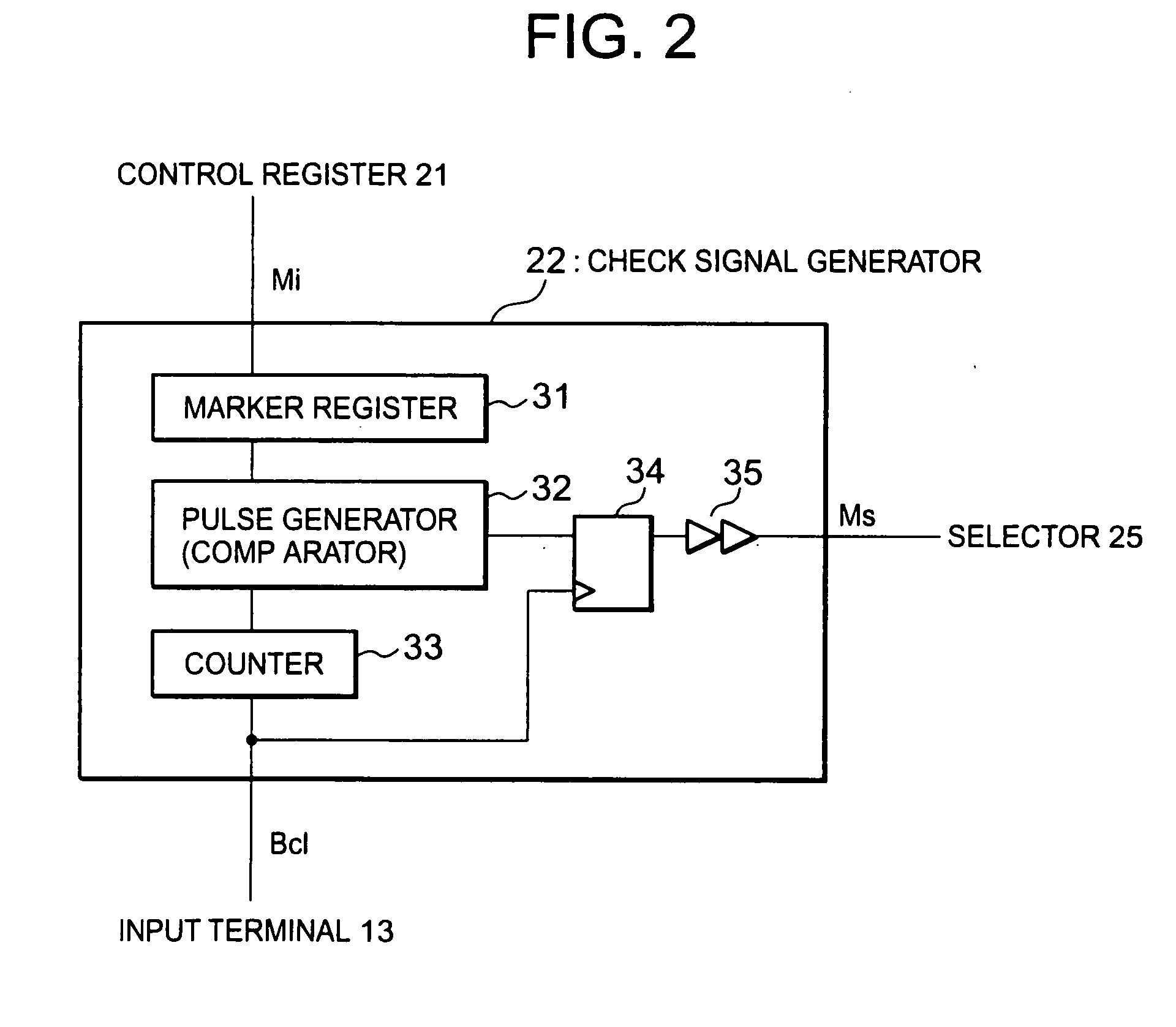Semiconductor device having built-in self-test circuit and method of testing the same
a technology of self-testing and semiconductor devices, which is applied in the direction of measurement devices, instruments, computing, etc., can solve the problems of increasing the cost of testing lsis, the inability to reduce the testing time beyond a certain extent, and the difficulty in determining the timing of reading a fault detection signal from the parallel conversion circuit, so as to reduce the cost of testing and accurate determination
- Summary
- Abstract
- Description
- Claims
- Application Information
AI Technical Summary
Benefits of technology
Problems solved by technology
Method used
Image
Examples
first exemplary embodiment
[0032]FIG. 1 is a block diagram showing a configuration of a semiconductor device according to a first exemplary embodiment of the present invention. Referring to FIG. 1, a semiconductor device 10 includes a BIST circuit 11, an SRAM 12, input terminals 13 and 14, and an output terminal 15. The BIST circuit includes a control register 21, a check signal generator 22, a pattern generation circuit 23, a comparator 24, and a selector 25.
[0033]The semiconductor device 10 has a tester clock signal Tc1 inputted thereto from an external test equipment 50 via the input terminal 13 and supplies the inputted tester clock signal Tc1 as a BIST clock signal Bc1 to the BIST circuit 11 and the SRAM 12. The BIST circuit 11 tests the SRAM 12 in synchronization with the BIST clock signal Bc1. The SRAM 12 reads and writes data used for the test in synchronization with the BIST clock signal Bc1.
[0034]The semiconductor device 10 has a BIST control signal Bct inputted thereto from the external test equipm...
second exemplary embodiment
[0048]FIG. 5 is a block diagram showing a configuration of a semiconductor device according to a second exemplary embodiment of the present invention. In FIG. 5, components identical to those shown in FIG. 1 are assigned the same reference numerals as in FIG. 1 and their descriptions are omitted. A semiconductor device 10a shown in FIG. 5 is like the semiconductor device 10 shown in FIG. 1 additionally including a PLL 16, a counter 17, and a serial / parallel converter 18.
[0049]The PLL 16 generates a BIST clock signal Bc1 by multiplying a tester clock signal Tc1 (by three in the present example) and supplies the BIST clock signal Bc1 thus generated to a BIST circuit 11, an SRAM 12, a counter 17, and a serial / parallel converter 18.
[0050]The counter 17 frequency-divides the BIST clock signal Bc1 (by three in the present example) and supplies the resultant signal as a collection signal Pei to the serial / parallel converter 18.
[0051]The serial / parallel converter 18 includes flip-flop circu...
third exemplary embodiment
[0054]FIG. 7 is a block diagram showing a configuration of a semiconductor device according to a third exemplary embodiment of the present invention. In FIG. 7, components identical to those shown in FIG. 1 are assigned the same reference numerals as in FIG. 1 and their descriptions are omitted. A semiconductor device 10b shown in FIG. 7 is like the semiconductor device 10 shown in FIG. 1 less the check signal generator 22 and the selector 25.
[0055]A pattern generation circuit 23b writes data for fault detection to an address to be a target of marker pulse generation of an SRAM 12. A comparator 24 detects the data for fault detection and outputs a marker pulse to a test result signal Ts. Namely, the control register 21b makes the pattern generation circuit 23b generate, before generating a test result signal, a prescribed marker pulse whose phase is the same as that of the test result signal. The test equipment 50 can accurately determine, like in the first exemplary embodiment, the...
PUM
 Login to View More
Login to View More Abstract
Description
Claims
Application Information
 Login to View More
Login to View More - R&D
- Intellectual Property
- Life Sciences
- Materials
- Tech Scout
- Unparalleled Data Quality
- Higher Quality Content
- 60% Fewer Hallucinations
Browse by: Latest US Patents, China's latest patents, Technical Efficacy Thesaurus, Application Domain, Technology Topic, Popular Technical Reports.
© 2025 PatSnap. All rights reserved.Legal|Privacy policy|Modern Slavery Act Transparency Statement|Sitemap|About US| Contact US: help@patsnap.com



